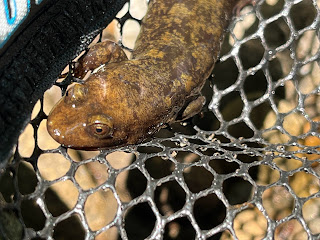

** These pages are under construction, bear with us
A biodiversity research program
The NatureServe Network outlined three questions to guide biodiversity research: What is it? Where is it? How is it doing?
What is it?
Discovery and enumeration of species and other "units" of biodiversity is foundational to understanding the biological world. It also raises deep questions about the nature of diversity: What is a species? Why is individual variation structured into identifiable groups? What causes and maintains the discontinuities between them? Our recent/current work in this area includes discovery of an unknown species of mudpuppy (Necturus), and a re-evaluation of species definitions of large woodland salamanders in the Great Smoky Mountains.
Where is it?
Geographical distributions and patterns of diversity have fascinated ecologists and evolutionary biologists since before these disciplines officially existed. How these patterns change has become an intense focus of conservation science in the light of climate change. Salamander distributions and patterns of coexistence are currently of great interest in the lab, and previous students have worked on the biogeography of fish, lizards, and turtles. We are also working on conceptual and statistical issues in the geography of diversity.
How is it doing?
Some of the most applied work in the lab addresses threats to population persistence, largely using the tools of population genetics. For example, we have contributed to the evaluation of a Bog Turtle restoration program, and current student Becca Smith is working on conservation genetics of Brook Trout in southern Appalachia. Other interests include impacts of invasive species on woodland salamanders, and anthropogenic effects on hybridization and competition among salamanders.



